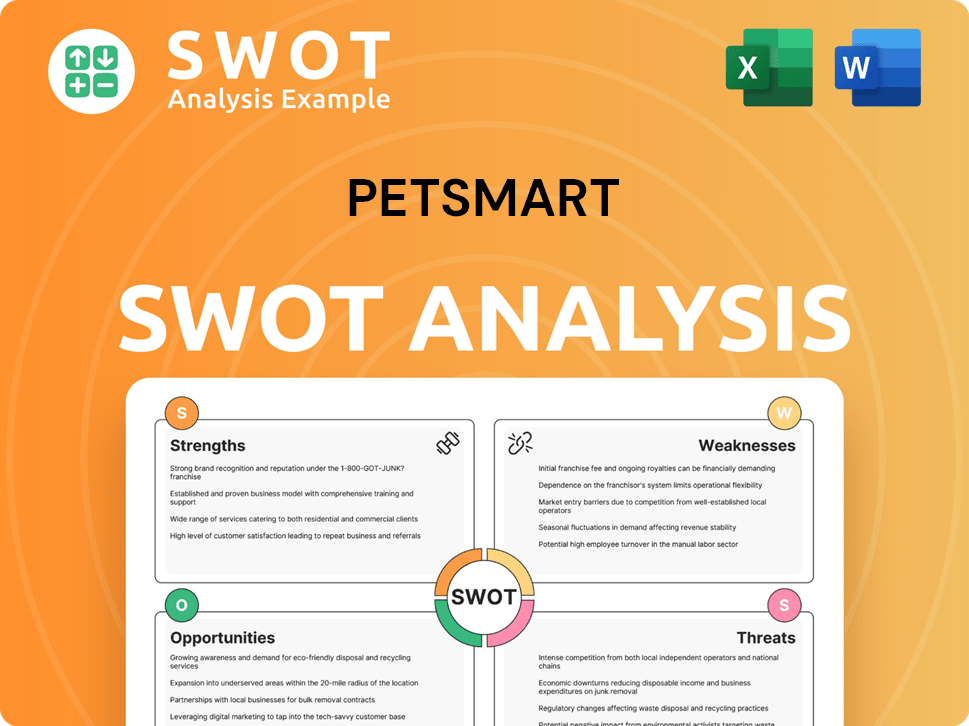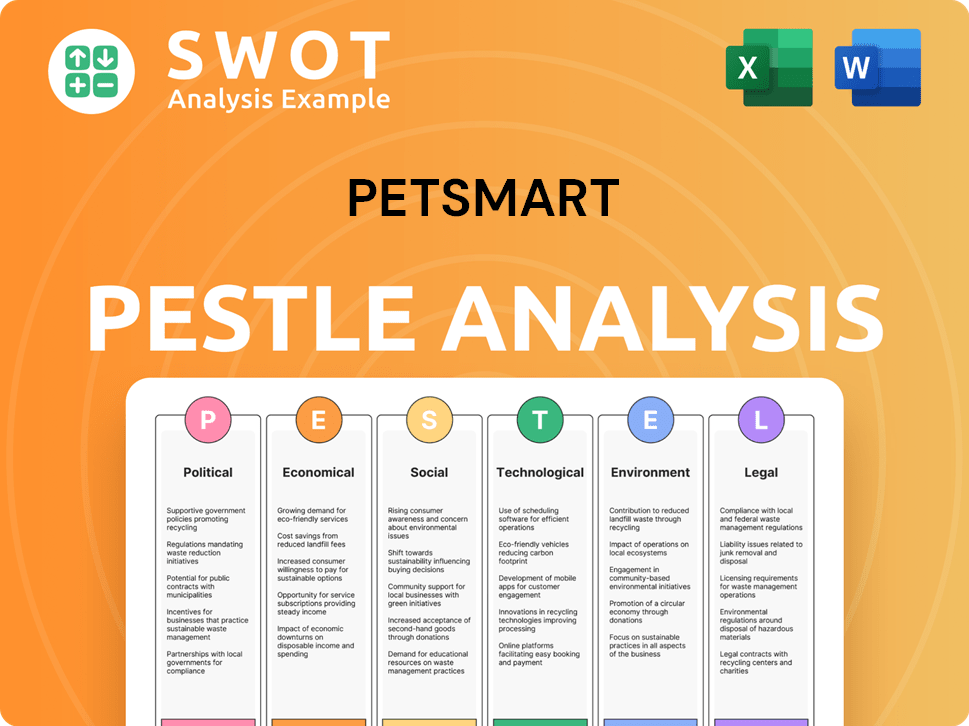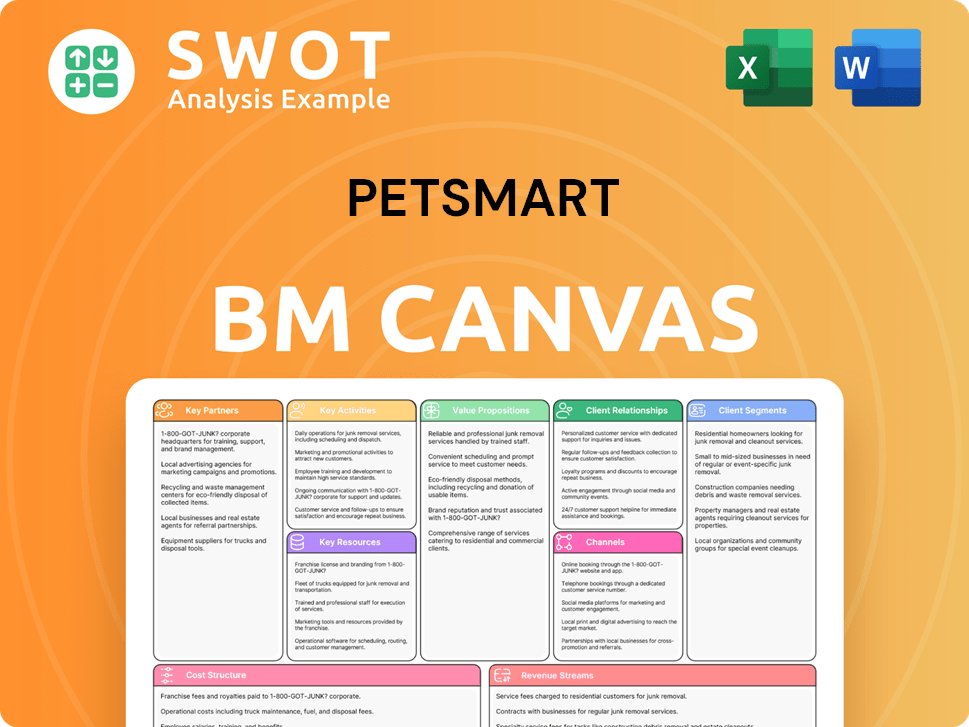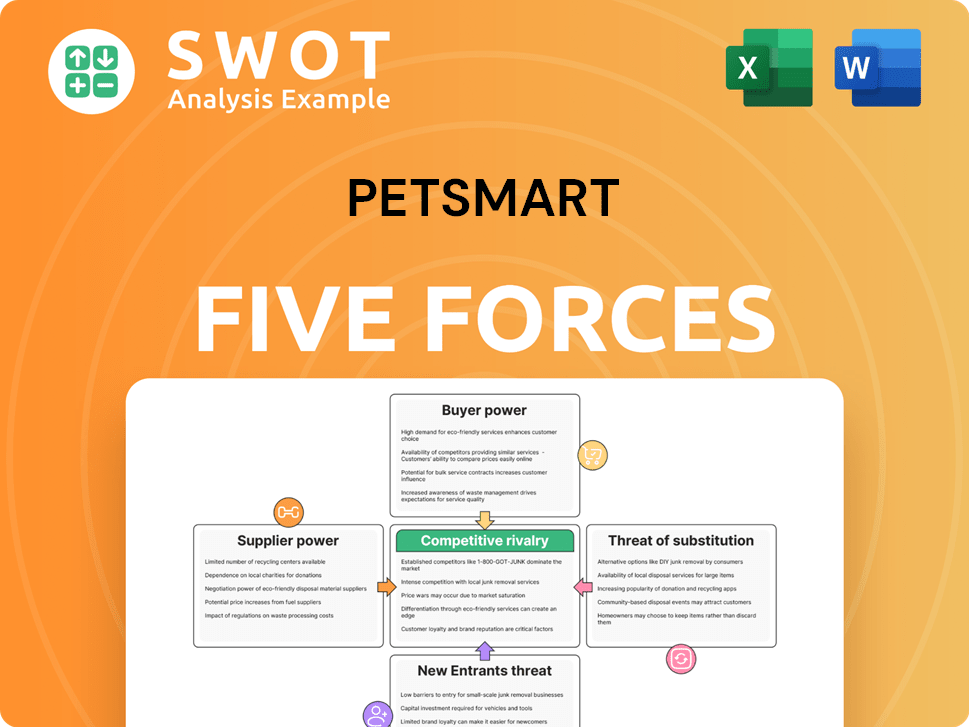Petsmart Bundle
How Did PetSmart Become a Pet Care Powerhouse?
From humble beginnings to a retail giant, PetSmart's story is a compelling case study in business evolution. This Petsmart SWOT Analysis reveals the strategic decisions that propelled the pet store chain to the forefront of the industry. Discover the key milestones and pivotal moments that shaped the Petsmart company into the brand we know today.

The Petsmart history is a testament to the power of adapting to changing consumer needs and market dynamics. Understanding the early Petsmart years, including its founding date and original name, is crucial to grasping its long-term success. This exploration will trace the Petsmart timeline, detailing its store expansion and evolution from a pet supplies retailer to a comprehensive pet care provider, highlighting key milestones in its journey.
What is the Petsmart Founding Story?
The Petsmart history began on August 14, 1986, when Jim Dougherty and Janice Dougherty established the company. The first two stores opened in Arizona in 1987, marking the beginning of a significant Pet store chain in the pet supply market. This marked a shift from the smaller, independent pet shops that were common at the time.
The founders aimed to create large, warehouse-style stores. These stores offered a wide array of pet products at competitive prices. Jim Dougherty, with his background in grocery store management, saw the potential to apply a big-box retail model to the fragmented pet supply market. The original name, PetFood Warehouse, reflected the initial focus on bulk pet food sales.
The early days of Petsmart company were marked by a clear vision to provide convenience and value to pet owners. This was achieved by offering a comprehensive selection of pet supplies in a single location. The company's rebranding to PetSmart in 1989 signaled a broader ambition. This included a full range of pet care solutions and services, expanding beyond just pet food.
Petsmart early years saw the company focusing on high-volume sales of pet food and supplies, a strategy that quickly gained traction. Initial funding came from personal investments and early venture capital, allowing for rapid expansion. The company's establishment reflected a growing consumer demand for specialized retail experiences.
- The company's success was built on the founders' expertise in retail operations.
- The burgeoning pet ownership trend in the late 1980s created a favorable economic context.
- The initial business model centered on high-volume sales of pet food and supplies.
- The company's growth was fueled by a shift towards treating pets as integral family members.
The Petsmart founding date is a key milestone in the company's history. It coincided with a rising trend in pet ownership and a growing demand for specialized retail experiences. The company's evolution is a testament to its ability to adapt and meet the changing needs of pet owners. For further insights into the current state of the company, you can explore Owners & Shareholders of Petsmart.
Petsmart SWOT Analysis
- Complete SWOT Breakdown
- Fully Customizable
- Editable in Excel & Word
- Professional Formatting
- Investor-Ready Format

What Drove the Early Growth of Petsmart?
The early growth of the PetSmart company was marked by rapid expansion across the United States. After the success of its initial stores, the pet supplies retailer quickly opened new locations, utilizing its warehouse-style format to offer a wide selection of products. This period also saw the introduction of key services, such as pet grooming, which diversified its offerings. The Petsmart history is a story of strategic growth and market adaptation.
Following the success of its initial stores, the Pet store chain rapidly expanded. By 1993, Petsmart had opened its 50th store, demonstrating significant momentum in its expansion strategy. This early growth phase was critical in establishing Petsmart as a national brand.
A pivotal moment in its early growth was its initial public offering (IPO) in 1993, which provided significant capital for further expansion and market penetration. This allowed Petsmart to accelerate its store openings and invest in infrastructure to support its growing operations. The Petsmart timeline is a story of strategic financial moves.
The company also began to explore strategic partnerships, notably with animal welfare organizations to facilitate in-store pet adoptions. This not only served a philanthropic purpose but also drove foot traffic and brand loyalty. The company's commitment to its mission is further detailed in Mission, Vision & Core Values of Petsmart.
The entry into new geographical markets was systematic, targeting areas with high pet ownership demographics. Leadership transitions during this period focused on bringing in executives with experience in large-scale retail operations and supply chain management to support the company's burgeoning footprint. The competitive landscape began to consolidate as Petsmart emerged as a dominant player.
Petsmart PESTLE Analysis
- Covers All 6 PESTLE Categories
- No Research Needed – Save Hours of Work
- Built by Experts, Trusted by Consultants
- Instant Download, Ready to Use
- 100% Editable, Fully Customizable

What are the key Milestones in Petsmart history?
The Petsmart history is marked by significant growth and strategic shifts within the pet store chain industry. From its early beginnings, the Petsmart company has continuously adapted to market changes, expanding its services and offerings to meet the evolving needs of pet owners. The Petsmart timeline showcases a commitment to innovation and customer satisfaction.
| Year | Milestone |
|---|---|
| 1986 | The company, originally known as PetFood Warehouse, was founded in 1986, marking the beginning of its journey in the pet supplies retail sector. |
| 1994 | PetSmart Charities was launched as an independent non-profit organization, reflecting a dedication to animal welfare. |
| 1994 | In-store pet adoption centers were introduced in partnership with local animal welfare organizations, facilitating over 10 million pet adoptions to date. |
| 1995 | The company went public, listing on the NASDAQ under the ticker PETM, which was an important step in its financial history. |
| 2000 | PetsHotel was acquired, expanding its service offerings to include pet boarding. |
| 2015 | The company was taken private by BC Partners for $8.7 billion, providing greater flexibility in long-term strategic planning. |
| 2017 | Chewy was acquired for approximately $3.35 billion, significantly bolstering its e-commerce capabilities and market share. |
The introduction of in-store pet adoption centers, starting in 1994, was a groundbreaking move that not only supported animal welfare but also enhanced the customer experience. The acquisition of PetsHotel in 2000 further diversified its services, offering comprehensive pet care solutions.
Partnerships with local animal welfare organizations, starting in 1994, have facilitated over 10 million pet adoptions, creating a unique customer experience.
The acquisition in 2000 allowed for the expansion of services to include pet boarding, providing a comprehensive pet care offering.
The acquisition of Chewy in 2017 was a strategic move to enhance its online presence and compete with online retailers.
The establishment of PetSmart Charities in 1994 demonstrated a commitment to philanthropic efforts within the pet community.
The rise of e-commerce and online retailers like Chewy presented a significant challenge, necessitating strategic adjustments to maintain market share. Economic downturns also impacted consumer spending, requiring a focus on value and essential pet care services.
The growth of online retailers like Chewy posed a significant competitive threat, driving the need for strategic e-commerce enhancements.
Economic challenges required a focus on value propositions and essential pet care services to maintain customer spending.
Navigating internal restructurings and leadership changes were essential for maintaining a competitive edge and driving innovation.
Petsmart Business Model Canvas
- Complete 9-Block Business Model Canvas
- Effortlessly Communicate Your Business Strategy
- Investor-Ready BMC Format
- 100% Editable and Customizable
- Clear and Structured Layout

What is the Timeline of Key Events for Petsmart?
The Petsmart history is a story of strategic growth and adaptation within the pet care industry. Founded in 1986 as PetFood Warehouse, the pet store chain quickly evolved, opening its first two stores in Arizona in 1987. Rebranding to Petsmart in 1989, the company expanded rapidly, culminating in an Initial Public Offering (IPO) in 1993. Key milestones include the establishment of PetSmart Charities in 1994 and the acquisition of PetsHotel in 2000. Further expansion included introducing PetSmart Banfield Veterinary Hospitals in 2009 and the acquisition of Chewy in 2017, significantly boosting its e-commerce presence. In 2020, a partnership with DoorDash for same-day delivery was announced. Chewy went public again in 2021, while PetSmart retained a substantial stake. As of 2024, Petsmart continues to focus on omnichannel retail and personalized pet care solutions.
| Year | Key Event |
|---|---|
| 1986 | Founded as PetFood Warehouse. |
| 1987 | First two stores open in Arizona. |
| 1989 | Rebranded to Petsmart. |
| 1993 | Initial Public Offering (IPO). |
| 1994 | PetSmart Charities is established and in-store pet adoptions begin. |
| 2000 | Acquires PetsHotel, entering the pet boarding market. |
| 2009 | Introduces PetSmart Banfield Veterinary Hospitals within its stores. |
| 2015 | Acquired by BC Partners, becoming a private company. |
| 2017 | Acquires Chewy, significantly expanding its e-commerce presence. |
| 2020 | Announces a significant partnership with DoorDash for same-day delivery. |
| 2021 | Chewy goes public again, with PetSmart retaining a significant stake. |
| 2023 | Continues to expand its services, focusing on omnichannel retail and personalized pet care solutions. |
| 2024 | Focuses on leveraging AI and data analytics to enhance customer experience and operational efficiency. |
Petsmart is strengthening its omnichannel retail strategy, integrating its physical stores with its online platform. This approach allows customers to shop seamlessly across different channels. This integration is crucial for meeting the evolving needs of pet owners. They are expected to offer a more convenient and cohesive shopping experience.
The company plans to leverage technology, including AI and data analytics, to personalize customer experiences. These technologies will also optimize inventory management and streamline operations. Enhanced customer experiences and operational efficiencies are key drivers for future growth. These innovations are crucial for staying competitive in the pet care market.
Petsmart is expected to continue expanding its services, especially in veterinary care and grooming. These services cater to the growing demand for comprehensive pet wellness solutions. Expanding service offerings is a key part of their strategy. This expansion aligns with the increasing trend of pet humanization.
The pet care market is projected to reach USD 325.7 billion by 2025, fueled by rising pet ownership. Petsmart's strategic initiatives align with these trends. The focus on digital transformation and service expansion is expected to maintain its competitive edge. These factors position the company for continued growth.
Petsmart Porter's Five Forces Analysis
- Covers All 5 Competitive Forces in Detail
- Structured for Consultants, Students, and Founders
- 100% Editable in Microsoft Word & Excel
- Instant Digital Download – Use Immediately
- Compatible with Mac & PC – Fully Unlocked

Related Blogs
- What is Competitive Landscape of Petsmart Company?
- What is Growth Strategy and Future Prospects of Petsmart Company?
- How Does Petsmart Company Work?
- What is Sales and Marketing Strategy of Petsmart Company?
- What is Brief History of Petsmart Company?
- Who Owns Petsmart Company?
- What is Customer Demographics and Target Market of Petsmart Company?
Disclaimer
All information, articles, and product details provided on this website are for general informational and educational purposes only. We do not claim any ownership over, nor do we intend to infringe upon, any trademarks, copyrights, logos, brand names, or other intellectual property mentioned or depicted on this site. Such intellectual property remains the property of its respective owners, and any references here are made solely for identification or informational purposes, without implying any affiliation, endorsement, or partnership.
We make no representations or warranties, express or implied, regarding the accuracy, completeness, or suitability of any content or products presented. Nothing on this website should be construed as legal, tax, investment, financial, medical, or other professional advice. In addition, no part of this site—including articles or product references—constitutes a solicitation, recommendation, endorsement, advertisement, or offer to buy or sell any securities, franchises, or other financial instruments, particularly in jurisdictions where such activity would be unlawful.
All content is of a general nature and may not address the specific circumstances of any individual or entity. It is not a substitute for professional advice or services. Any actions you take based on the information provided here are strictly at your own risk. You accept full responsibility for any decisions or outcomes arising from your use of this website and agree to release us from any liability in connection with your use of, or reliance upon, the content or products found herein.